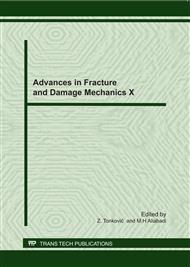p.303
p.307
p.311
p.315
p.319
p.323
p.327
p.331
p.335
Small Fatigue Crack Growth Behavior from Artificial Notch with Focused Ion Beam in Annealed 0.45% Carbon Steel
Abstract:
The aim of this study is firstly to investigate the applicability of a sharp notch with Focused Ion Beam (FIB) as a crack for fatigue limit evaluation. Secondly we investigate a condition in which artificial defects (drilled hole, FIB notch) can be used as a crack for fatigue limit evaluation. To achieve the aim, the growth behaviors and the non-propagating crack sizes of small fatigue cracks initiated from a FIB notch and a drilled hole are carefully compared with those of an annealed fatigue crack which imitates an ideally sharp crack. The results show that a FIB notch can be used as a crack for fatigue limit evaluation under some conditions. The results also show that the condition which controls the applicability of an artificial defect as an ideal crack for fatigue limit evaluation is strongly dependent on the relation between (i) the length of a non-propagating fatigue crack and (ii) the crack length when the small fatigue crack growth behaviors from an artificial defect and an ideal pre-crack become almost the same. It is found that the length of (ii) can be obtained by the analyses using the number of cycles from a certain crack length to failure.
Info:
Periodical:
Pages:
319-322
Citation:
Online since:
September 2011
Authors:
Price:
Сopyright:
© 2012 Trans Tech Publications Ltd. All Rights Reserved
Share:
Citation:


